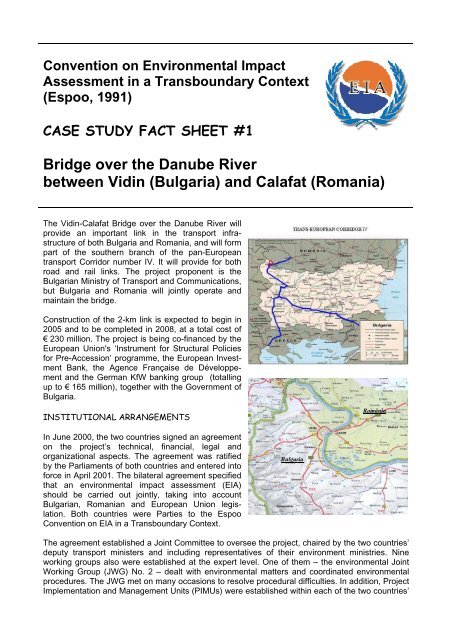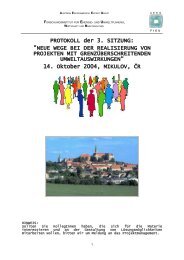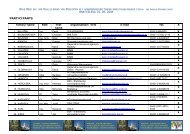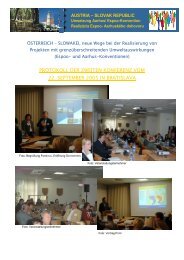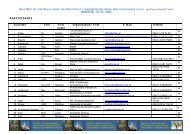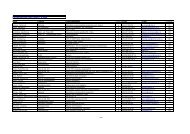Bridge over the Danube River between Vidin (Bulgaria ... - UNECE
Bridge over the Danube River between Vidin (Bulgaria ... - UNECE
Bridge over the Danube River between Vidin (Bulgaria ... - UNECE
- No tags were found...
Create successful ePaper yourself
Turn your PDF publications into a flip-book with our unique Google optimized e-Paper software.
Convention on Environmental Impact<br />
Assessment in a Transboundary Context<br />
(Espoo, 1991)<br />
CASE STUDY FACT SHEET #1<br />
<strong>Bridge</strong> <strong>over</strong> <strong>the</strong> <strong>Danube</strong> <strong>River</strong><br />
<strong>between</strong> <strong>Vidin</strong> (<strong>Bulgaria</strong>) and Calafat (Romania)<br />
The <strong>Vidin</strong>-Calafat <strong>Bridge</strong> <strong>over</strong> <strong>the</strong> <strong>Danube</strong> <strong>River</strong> will<br />
provide an important link in <strong>the</strong> transport infrastructure<br />
of both <strong>Bulgaria</strong> and Romania, and will form<br />
part of <strong>the</strong> sou<strong>the</strong>rn branch of <strong>the</strong> pan-European<br />
transport Corridor number IV. It will provide for both<br />
road and rail links. The project proponent is <strong>the</strong><br />
<strong>Bulgaria</strong>n Ministry of Transport and Communications,<br />
but <strong>Bulgaria</strong> and Romania will jointly operate and<br />
maintain <strong>the</strong> bridge.<br />
Construction of <strong>the</strong> 2-km link is expected to begin in<br />
2005 and to be completed in 2008, at a total cost of<br />
€ 230 million. The project is being co-financed by <strong>the</strong><br />
European Union's ‘Instrument for Structural Policies<br />
for Pre-Accession’ programme, <strong>the</strong> European Investment<br />
Bank, <strong>the</strong> Agence Française de Développement<br />
and <strong>the</strong> German KfW banking group (totalling<br />
up to € 165 million), toge<strong>the</strong>r with <strong>the</strong> G<strong>over</strong>nment of<br />
<strong>Bulgaria</strong>.<br />
INSTITUTIONAL ARRANGEMENTS<br />
România<br />
In June 2000, <strong>the</strong> two countries signed an agreement<br />
on <strong>the</strong> project’s technical, financial, legal and<br />
organizational aspects. The agreement was ratified<br />
by <strong>the</strong> Parliaments of both countries and entered into<br />
force in April 2001. The bilateral agreement specified<br />
that an environmental impact assessment (EIA)<br />
should be carried out jointly, taking into account<br />
<strong>Bulgaria</strong>n, Romanian and European Union legislation.<br />
Both countries were Parties to <strong>the</strong> Espoo<br />
Convention on EIA in a Transboundary Context.<br />
<strong>Bulgaria</strong><br />
The agreement established a Joint Committee to <strong>over</strong>see <strong>the</strong> project, chaired by <strong>the</strong> two countries’<br />
deputy transport ministers and including representatives of <strong>the</strong>ir environment ministries. Nine<br />
working groups also were established at <strong>the</strong> expert level. One of <strong>the</strong>m – <strong>the</strong> environmental Joint<br />
Working Group (JWG) No. 2 – dealt with environmental matters and coordinated environmental<br />
procedures. The JWG met on many occasions to resolve procedural difficulties. In addition, Project<br />
Implementation and Management Units (PIMUs) were established within each of <strong>the</strong> two countries’
competent authorities – <strong>the</strong> Romanian Ministry of Transport Construction and Tourism and <strong>the</strong><br />
<strong>Bulgaria</strong>n Ministry of Transport and Communications.<br />
The location of <strong>the</strong> bridge was selected through a route selection study – examining environmental,<br />
social and economic aspects – carried out in <strong>the</strong> 1990s. A study completed in July 2001 determined<br />
<strong>the</strong> optimal location of <strong>the</strong> bridge.<br />
EIA PROCEDURE<br />
<strong>Bulgaria</strong> has a one-step EIA procedure at <strong>the</strong> beginning of <strong>the</strong> project design process, whereas<br />
Romania has EIA in <strong>the</strong> framework of <strong>the</strong> permitting process (i.e. before obtaining <strong>the</strong> construction<br />
permit). To resolve this difference, and to provide a stronger <strong>over</strong>all EIA, <strong>the</strong> transboundary EIA<br />
took place in two stages:<br />
• a preliminary EIA according to <strong>Bulgaria</strong>n legislation, and<br />
• a final EIA according to Romanian legislation.<br />
View from <strong>the</strong> Romanian side towards <strong>Bulgaria</strong>: <strong>the</strong><br />
<strong>Danube</strong> Navigational Channel and <strong>the</strong> Nameless Island.<br />
The arrow indicates <strong>the</strong> future location of <strong>the</strong> bridge.<br />
View from <strong>the</strong> <strong>Bulgaria</strong>n side to <strong>the</strong> future<br />
location of <strong>the</strong> bridge.<br />
Experts from an international consulting company led <strong>the</strong> EIA team, which also included local<br />
consultants from <strong>Bulgaria</strong> and Romania. The local experts were licensed or registered as is<br />
required by <strong>Bulgaria</strong>n and Romanian legislation. No formal notification procedure under <strong>the</strong><br />
Convention was considered necessary and nor was screening undertaken – a joint EIA had been<br />
decided upon in <strong>the</strong> bilateral agreement. The joint EIA team prepared <strong>the</strong> EIA documentation and<br />
<strong>the</strong> PIMUs provided full translation into <strong>Bulgaria</strong>n, Romanian and English (20 copies of each), with<br />
<strong>the</strong> PIMUs c<strong>over</strong>ing <strong>the</strong>se costs. The preliminary EIA was completed in August 2001.<br />
The competent authorities in <strong>Bulgaria</strong> and<br />
Romania notified <strong>the</strong>ir own public right at <strong>the</strong><br />
start of <strong>the</strong> EIA process, using <strong>the</strong> methods<br />
listed in <strong>the</strong> table. The <strong>Bulgaria</strong>n authorities<br />
and EIA experts consulted <strong>the</strong> public during<br />
<strong>the</strong> preparation of <strong>the</strong> preliminary EIA and on<br />
<strong>the</strong> preliminary and final EIA report. The<br />
Romanian competent authorities also notified<br />
<strong>the</strong> public about <strong>the</strong> possibility to consult<br />
<strong>the</strong> final EIA report, and <strong>the</strong> project proposal,<br />
and about <strong>the</strong> public hearing that took place<br />
in December 2004.<br />
Notification methods <strong>Bulgaria</strong> Romania<br />
Local newspapers <br />
National newspapers <br />
Local radio<br />
<br />
Television<br />
<br />
Post to local NGOs<br />
<br />
Post to national NGOs <br />
Post to concerned national,<br />
district and local authorities<br />
<br />
Displayed on web-pages of<br />
<br />
environmental authorities and<br />
developer’s
The preliminary EIA documentation was distributed to <strong>the</strong> competent authorities in <strong>Bulgaria</strong> (in<br />
<strong>Bulgaria</strong>n and in English) and Romania (in Romanian and in English) and to <strong>the</strong> <strong>Vidin</strong> municipality,<br />
<strong>Bulgaria</strong> (in <strong>Bulgaria</strong>n). The documentation was also available for one month to all interested<br />
members of <strong>the</strong> public, representatives of NGOs and o<strong>the</strong>r interested parties. The JWG had<br />
established a time limit for receiving written comments from <strong>the</strong> public and o<strong>the</strong>r concerned parties<br />
in both countries.<br />
<strong>Danube</strong> shoreline, Romania<br />
<strong>Danube</strong> shoreline in summer, <strong>Bulgaria</strong> – view to <strong>the</strong> bridge axis<br />
Based on <strong>the</strong> preliminary EIA report, and in accordance with <strong>Bulgaria</strong>n and Romanian legislation,<br />
<strong>the</strong> competent environmental authorities and local authorities from both countries also organized<br />
public hearings, with <strong>the</strong> public concerned and with non-g<strong>over</strong>nmental organizations (NGOs), in<br />
Calafat and <strong>Vidin</strong> in January 2002. The competent authority in each country provided minutes from<br />
<strong>the</strong> meetings with comments made during <strong>the</strong> public hearing. The PIMU translated <strong>the</strong> comments<br />
into English and forwarded <strong>the</strong>m to <strong>the</strong> competent authority in <strong>the</strong> o<strong>the</strong>r country. In total, only ten<br />
comments were received from <strong>the</strong> Romanian public and seven from <strong>the</strong> <strong>Bulgaria</strong>n. The Calafat and<br />
<strong>Vidin</strong> municipalities c<strong>over</strong>ed <strong>the</strong> costs of organizing <strong>the</strong> public hearings, and of <strong>the</strong> necessary<br />
interpretation. The participants in <strong>the</strong> public hearings c<strong>over</strong>ed <strong>the</strong>ir own costs. During this public<br />
participation procedure, <strong>the</strong>re were no objections from <strong>the</strong> public or from <strong>the</strong> NGOs, only<br />
comments on mitigation measures to reduce environmental impacts and o<strong>the</strong>r improvements.<br />
Based on <strong>the</strong> preliminary EIA report, and<br />
taking into account <strong>the</strong> results from <strong>the</strong><br />
public hearings, <strong>the</strong> <strong>Bulgaria</strong>n Ministry of<br />
Environment and Water issued its EIA<br />
decision in February 2002. The decision<br />
stipulated specific conditions, being<br />
measures for preventing or limiting<br />
significant adverse impacts on <strong>the</strong><br />
environment. The implementation of <strong>the</strong>se<br />
measures will ensure that <strong>the</strong> requirements<br />
of <strong>the</strong> legislation are observed. The<br />
project proponent did not contest <strong>the</strong><br />
conditions. The Romanian competent environmental<br />
authority issued its opinion on<br />
Ferryboat harbour on <strong>the</strong> Calafat side.<br />
<strong>the</strong> preliminary EIA Report, which was<br />
sent to <strong>the</strong> <strong>Bulgaria</strong>n competent authority. The information on <strong>the</strong> EIA decision was published in a<br />
<strong>Bulgaria</strong>n national newspaper, and copies were given to <strong>the</strong> project proponent, to <strong>the</strong> local<br />
municipality and to <strong>the</strong> concerned authorities. The decision was translated into English and sent to<br />
<strong>the</strong> Romania competent authority through <strong>the</strong> PIMU.<br />
FINAL EIA REPORT<br />
The final EIA was completed in October 2004. The final EIA report provided more information<br />
about <strong>the</strong> proposed project’s effects on <strong>the</strong> Romanian side than did <strong>the</strong> preliminary EIA report. The<br />
final report was drawn up in English, Romanian and <strong>Bulgaria</strong>n, and it was <strong>the</strong> subject of <strong>the</strong> public
hearing in December 2004. The public hearing was held in Calafat, Romania. Besides <strong>the</strong><br />
Romanian and <strong>Bulgaria</strong>n authorities and <strong>the</strong> EIA experts who drew up <strong>the</strong> final EIA Report, <strong>the</strong>re<br />
were present <strong>the</strong> public concerned and representatives of one national NGO. The questions and<br />
answers and <strong>the</strong> comments on <strong>the</strong> project and <strong>the</strong> EIA report were recorded in <strong>the</strong> minutes of <strong>the</strong><br />
hearing. The discussions showed <strong>the</strong> willingness of <strong>the</strong> Romanian public and authorities to support<br />
<strong>the</strong> project, taking into account <strong>the</strong> opportunities for <strong>the</strong> development of <strong>the</strong> region, expected to<br />
arise from <strong>the</strong> proposed bridge.<br />
<strong>Bulgaria</strong>n legislation does not require fur<strong>the</strong>r public participation based on <strong>the</strong> final EIA report.<br />
Never<strong>the</strong>less, <strong>the</strong> report was made available to <strong>the</strong> public in <strong>Bulgaria</strong>, and <strong>the</strong> proponent was<br />
prepared to record comments. However, no written comments were received. The <strong>Bulgaria</strong>n<br />
Ministry of Environment and Water undertook to prepare a written opinion on <strong>the</strong> final EIA report.<br />
Romanian legislation provides for a single EIA procedure (with a single EIA report), called an<br />
“environmental agreement”, which starts at <strong>the</strong> moment of <strong>the</strong> feasibility study and ends with <strong>the</strong><br />
issue of <strong>the</strong> final decision, before <strong>the</strong> project is started.<br />
The alternatives presented for <strong>the</strong> construction of <strong>the</strong> bridge:<br />
Nameless Island<br />
Navigation Channel<br />
Option A1- (Concrete <strong>Bridge</strong>)<br />
Superstructure spans <strong>over</strong> <strong>the</strong> <strong>Danube</strong> river – In situ<br />
cantilevered construction. Approach viaduct<br />
superstructure – Built in situ on formwork or in cantilever,<br />
ei<strong>the</strong>r supported from <strong>the</strong> ground, or supported on<br />
trusses attached to permanent and/or temporary piers.<br />
Option E – (Cable Stayed <strong>Bridge</strong>) – Main tower<br />
Cable stayed spans – steel sections would be lifted from<br />
<strong>the</strong> river. The concrete deck could be ei<strong>the</strong>r cast in situ,<br />
prefabricated and placed in panels with in situ joints, or<br />
cast with <strong>the</strong> steel part prior to lifting. Construction would<br />
be by balanced cantilever from <strong>the</strong> main tower. Non<br />
cable-stayed superstructure spans and approach viaduct<br />
spans - Built in situ on formwork, ei<strong>the</strong>r supported from<br />
<strong>the</strong> ground, or supported on trusses attached to<br />
permanent and/or temporary piers.<br />
Option G (Composite <strong>Bridge</strong>)<br />
Truss superstructure spans – The steel trusses and o<strong>the</strong>r<br />
steel elements would be prefabricated in sections. These<br />
could <strong>the</strong>n be ei<strong>the</strong>r lifted into place using marine and<br />
land cranes, or launched from ei<strong>the</strong>r <strong>the</strong> <strong>Bulgaria</strong>n or<br />
Romanian Banks. Temporary steelwork and/or temporary<br />
piers are likely to be necessary for <strong>the</strong> launched<br />
approach. The upper and lower concrete decks would be<br />
cast in situ.<br />
Prepared by Vania Grigorova of <strong>the</strong> <strong>Bulgaria</strong>n Ministry of Environment and<br />
Water and Daniela Pineta of <strong>the</strong> Romanian Ministry of Waters and Environmental<br />
Protection, with <strong>the</strong> support of <strong>the</strong> Espoo Convention’s Secretariat.<br />
December 2004<br />
www.unece.org/env/eia<br />
United Nations Economic Commission for Europe


